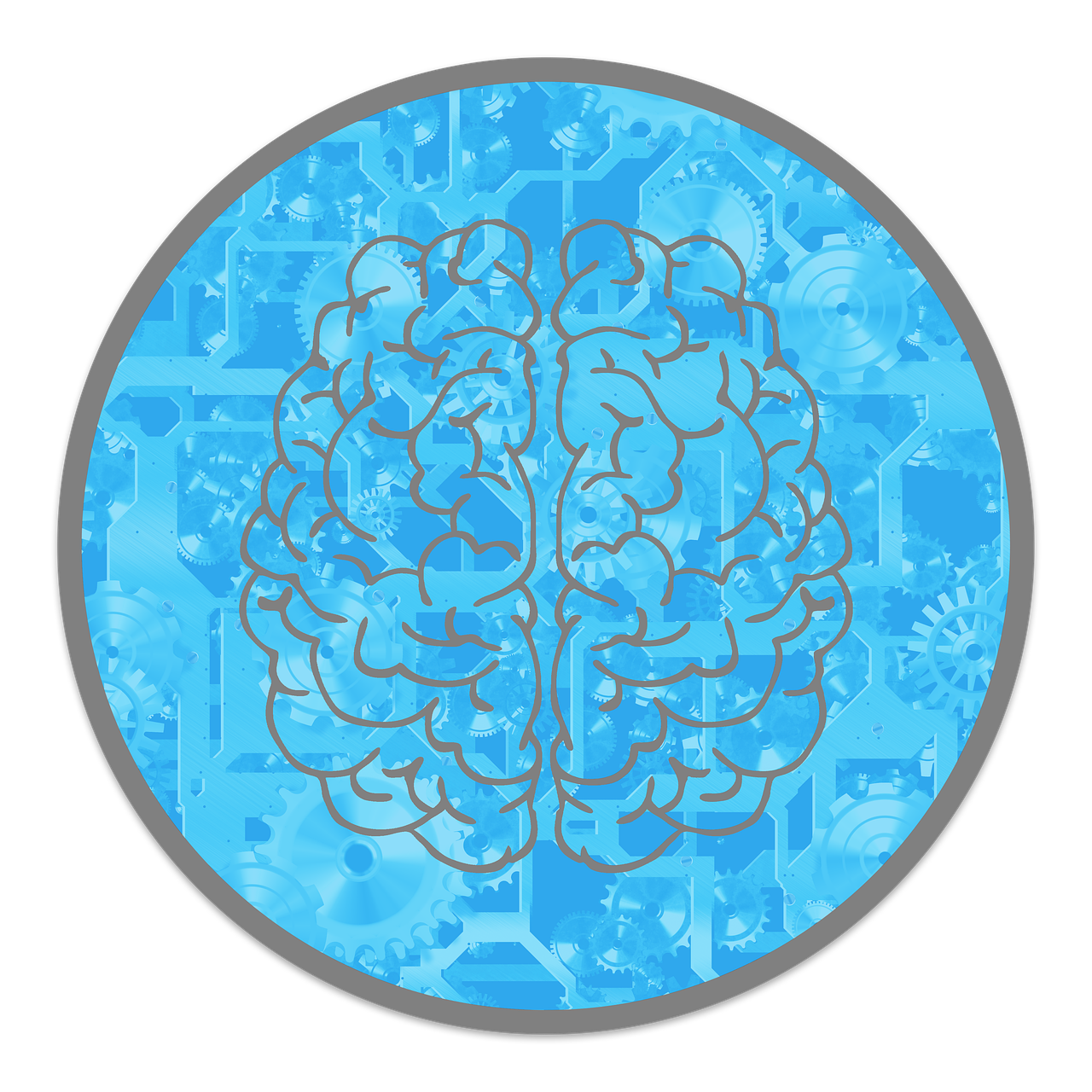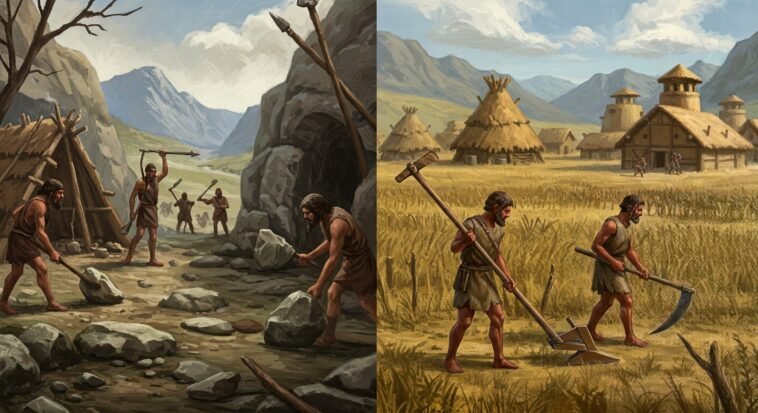
Alright, here’s the deal: the Stone Age and the Bronze Age are like the early chapters of humanity’s glow-up story.
The Stone Age was all about rocks and sticks—basic survival mode.
But then came the Bronze Age, and BAM!
We swapped rocks for metal, and everything went from “Me, hunt for food” to “Me, build cities and wage epic battles.”
This switch wasn’t just about fancier tools—it triggered massive changes in farming, warfare, and how humans organized themselves.
Think of it like upgrading from an old flip phone to a smartphone: once we had bronze, we could do more, faster, and smarter.
So, why should we care?
Well, understanding how those ancient shifts happened can help us understand how we keep leveling up as a society today.
We might not be using bronze anymore, but the pattern of innovation is still the same.
What Was the Stone Age?
The Stone Age is like humanity’s longest “trial and error” period, lasting from about 3.4 million years ago until around 3300 BCE. Why “Stone” Age?
Because humans were basically the original rockstars—using stone tools to hunt, build, and survive.
The stone age’s epic phases:
- Paleolithic (Old Stone Age) – Humans living the ultimate nomadic life, hunting and gathering, moving like a nomadic squad with no fixed address.
- Mesolithic (Middle Stone Age) – Humans were still using stone tools but started getting creative—settling in one spot sometimes and crafting more advanced tools.
- Neolithic (New Stone Age) – Humans figured out farming and began to stay put. No more wandering around like lost tourists.
Key features:
- Tools made from flint, obsidian, and other stones (basically ancient human’s version of the Swiss Army knife)
- Nomadic or semi-nomadic lifestyles (basically living life like a traveling rock band)
- Cave paintings and symbolic art (early human “selfies” and graffiti)
- Small tribal groups with pretty chill, equal societies (think low-key, no need for a king)
- The start of farming and animal domestication (basically turning “wild” into “homegrown” food)

What Was the Bronze Age?
The Bronze Age kicked off around 3300 BCE and lasted until about 1200 BCE (though it depended on where you were).
It’s called the “Bronze” Age because people started using bronze—a super useful metal mix of copper and tin—for everything from tools to weapons to art.
And trust me, this age was like the world’s first tech upgrade.
This era wasn’t just about shiny new tools—it was a time when civilizations started to level up big time.
Think Mesopotamia, Ancient Egypt, the Indus Valley, and Ancient China.
These places went from basic survival to full-on empires.
- Read also: 6 Prehistoric Artifacts That Could Change History
- Read also: Explained: How Prehistoric Human Evolution Is Mapped Incorrectly
Key features
- Metal tools and weapons – Swords, shields, and plows made from metal. Humans basically went from stone age to tech upgrade like, boom!
- Writing systems – People started recording stuff! Ancient Sumerians wrote in cuneiform, Egyptians used hieroglyphics—basically, the OG forms of texting.
- Cities and large-scale farming – No more living in caves. Now we have cities, and the agriculture? It’s next-level with massive fields feeding thousands.
- Complex political systems – Monarchies, empires, and rulers who wore crowns like they were royalty.
- Trade networks – People weren’t just sticking to their hometowns. They were trading across continents, like the world’s first international marketplace.
- Big architecture and religion – Monuments, temples, and pyramids started popping up everywhere. People were building massive structures—and organizing religion.
Stone vs. Bronze Tools: A Technological Leap
So, what’s the big deal about switching from stone tools to bronze?
It’s like going from a flip phone to a smartphone.
The key was the discovery of metallurgy—basically, humans figured out how to make metal work for them, and boom, everything changed.
Stone tools
- How they were made: Chipped or ground from rocks—basically like making an ancient paperweight.
- Strength: Blunt and easily breakable. Imagine trying to use a rock hammer to build a house. Not the most efficient.
- Mass production: Not exactly mass-produced. Every stone tool was basically unique, like a one-of-a-kind handcrafted item.
Bronze tools
- Strength: Stronger, sharper, and way more durable. Think of them like the difference between using a butter knife and a samurai sword.
- Precision: With bronze, humans could get way more precise with farming, building, and crafting—basically leveling up from “just surviving” to “actually thriving.”
- Warfare: Bronze also made weapons way better. Imagine upgrading from a club to a bronze sword—way more cutting-edge. (Literally.)

From Foragers to Farmers to Empires
1. Agriculture and food surplus
The Neolithic period kicked off farming, but the Bronze Age? It made farming pop.
With stronger plows and better irrigation tools, civilizations could grow way more food.
This wasn’t just about surviving—it was about thriving.
- Stone Age: You’re farming to get by. Think small, “just enough to eat” vibes.
- Bronze Age: You’ve got food for days. Think large-scale farms, food storage, and the kind of surplus that makes you think, “Why not share this with the neighbors?”
2. Population growth
More food meant more mouths to feed, and that’s when things started getting busy.
Populations grew, and guess what that led to?
Cities, social roles, and some very complex social structures.
- Urban Settlements: People started moving into cities, not just hanging out in villages. It’s like upgrading from a one-room schoolhouse to a whole high school.
- Division of Labor: Everyone had a role—whether you were a farmer, builder, or one of those ancient “royal advisors” who gave out questionable advice.
- Social Hierarchies: Think Game of Thrones—with kings, priests, and warriors ruling the roost while the rest of society got to work.
3. Trade and currency
Bronze wasn’t just cool to work with—it was valuable.
People started trading it all over, creating huge networks that connected civilizations.
This is how early economies and even the idea of money got its start.
- Cross-regional trade: Imagine a road trip from Mesopotamia to the Indus Valley. Now, add tons of goods being traded—like silk, metals, and maybe some ancient deals.
- Proto-currencies: Money wasn’t exactly like cash today, but early systems of trade helped set the stage for the economies we know now.
Social and Political Transformation
One of the biggest shifts from the Stone Age to the Bronze Age was how people organized their societies—kind of like going from “summer camp” to “government.”
Let’s break it down:
Stone Age society
- Small, Kin-Based Groups: Picture this: a small tribe of family and friends sticking together, hunting, and surviving as a tight-knit crew. Like a tiny, ancient squad.
- Relatively egalitarian: Everyone had a say, and there wasn’t much of a “boss.” It’s like a group project where everyone’s voice counted (sort of).
- Limited Specialization: People wore a lot of hats—hunter, gatherer, fire-maker—because there wasn’t much need for specialization.
Bronze Age society
- Rise of Kings and ruling classes: The Bronze Age was all about having the crown and leading large groups. Think of it like the first “monarchy” power move.
- Bureaucracies and centralized governments: Instead of just a handful of people calling the shots, now we’ve got entire systems and organizations running the show.
- Codified laws: The Bronze Age introduced written laws—because someone had to keep track of who stole whose sheep.
- Social classes and job specialization: Not everyone was just a farmer anymore. Some people specialized in specific jobs (like builders, scribes, or priests), and there were clear social classes.
The Birth of Writing and Record-Keeping
The Bronze Age didn’t just upgrade tools and societies—it brought writing into the picture.
Now, humans could start recording everything they were doing—no more relying on memory or oral storytelling.
What people started writing
- Trade transactions: “I’ll trade you 20 sacks of grain for that shiny bronze sword.” That’s a deal worth documenting.
- Religious practices: Priests were busy writing down the who, what, where, and why of their gods and rituals.
- Political Laws: From Hammurabi to Pharaohs, rulers needed to keep track of their legal “rules of the road.”
- Mythologies and historical events: Epic stories of gods, heroes, and dynasties—kind of like ancient Marvel movies, but in writing.
Examples of writing systems:
- Cuneiform (Mesopotamia): Like the OG emoji—but in clay form.
- Hieroglyphics (Egypt): Picture cool, colorful symbols that told ancient stories. It’s like if hieroglyphs were the first ancient Instagram posts.
- Oracle Bone Script (China): Think of it as early texting with animal bones.
Religion and Monumental Architecture
In the Stone Age, people had spiritual beliefs—think animism and nature worship—but when the Bronze Age hit, religion went from “personal vibes” to full-on institutionalized worship.
Stone Age spirituality
- Animism and nature worship: Back in the day, people believed everything had a spirit—trees, rocks, even rivers were sacred.
- Burial rites and ancestor reverence: People honored their dead and respected their ancestors—kind of like how you might keep your grandparents’ old photos or heirlooms.
Bronze Age religion
- Organized priesthoods: Priests and priestesses were the “influencers” of their time, running temples and overseeing rituals.
- Temples and religious centers: People weren’t just worshipping at home anymore—they built temples.
- Complex pantheons: Bronze Age religions had entire teams of gods. Egypt had Ra and Osiris, Mesopotamia had Inanna and Enki.
- Monumental architecture: Religious buildings got massive. The ziggurats of Sumer and the Pyramids of Egypt were like the skyscrapers of the ancient world, showing off both religious and political power.

Why the Shift Still Matters Today
1. Understanding human progress
The jump from the Stone Age to the Bronze Age isn’t just about cool new tools—it’s about how technology drives change.
Every step forward in agriculture, city-building, or writing was powered by a new tool or idea.
It’s like the world’s first technology boom.
2. Lessons in sustainability
The Bronze Age didn’t last forever.
Around 1200 BCE, civilizations collapsed due to climate change, warfare, and economic problems.
Sound familiar?
It’s like the ancient version of today’s environmental and political crises.
Looking back helps us figure out how to tackle today’s risks.
3. Foundations of modern systems
A lot of the systems we use today got their start in the Bronze Age:
- Early democracy: Ideas of leadership and government (though it wasn’t exactly voting yet).
- Laws and written communication: Hammurabi’s code? That’s the OG of rulebooks.
- Big-scale economies and trade: They were basically the first global economy—think of it like ancient Amazon, but with fewer drones.
- Proto-science and math: People started laying the groundwork for understanding the universe—kind of like ancient scientists doing their thing without a lab coat.
Recap: Key Differences Between the Stone Age and Bronze Age
| Category | Stone Age | Bronze Age |
| Tools | Stone (flint, obsidian) |
Bronze (copper + tin)
|
| Lifestyle | Hunter-gatherer → farming |
Settled civilizations
|
| Social Structure | Tribal, egalitarian |
Hierarchies, monarchies
|
| Writing | None |
Developed (e.g., cuneiform)
|
| Religion | Animistic, basic rituals |
Organized religion
|
| Trade | Minimal or local |
Widespread and international
|
| Architecture | Huts, basic shelters |
Palaces, temples, fortresses
|
- Read also: Prehistoric Myths: What We Got Wrong About Early Humans
- Read also: Wealthiest Family: 10+ Most Powerful Families in History
Final Thoughts: The Stone to Bronze Upgrade
The shift from the Stone Age to the Bronze Age wasn’t just about finding cooler tools—it was like upgrading from a flip phone to a smartphone.
It was a massive leap for civilization, and it set the stage for some of the things we now take for granted: writing, big governments, global trade, and massive religions.
Basically, the Bronze Age laid the foundation for everything we consider “modern life.”
By studying this epic transformation, we can understand where our societies started, why things evolved the way they did, and how innovation can shape (or shake) civilizations.
It’s like looking at the ancient roots of the world’s biggest plot twist.



